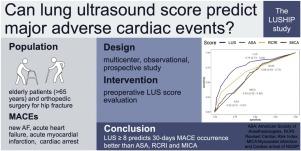Accuracy of preoperative lung ultrasound score for the prediction of major adverse cardiac events in elderly patients undergoing HIP surgery under spinal anesthesia: The LUSHIP multicenter observational prospective study
IF 3.7
3区 医学
Q1 ANESTHESIOLOGY
引用次数: 0
Abstract
Background and objective
We hypothesize that lung ultrasound scores (LUS) can help stratify the cardiac risk of elderly patients undergoing orthopedic surgery for hip fracture, adding value to the Revised Cardiac Risk Index (RCRI), the American Society of Anesthesiologists Physical Status (ASA-PS) and the National Surgical Quality Improvement Program Myocardial infarction and Cardiac arrest (NSQIP-MICA).
Methods
Prospective, observational multicenter study of 11 Italian hospitals on patients aged >65 years with hip fractures needing urgent surgery. Subjects with major adverse cardiovascular events (MACE) in the previous 6 months or with ongoing acute heart failure were excluded. Trained anesthesiologists obtained preoperative LUS scores during preoperative evaluation. ROC curve analysis and comparison were used to evaluate test accuracy.
Results
A total of 877 patients were enrolled in the study period. 108 MACE events occurred in 98 patients, with an overall incidence of 11.2%. LUS score was higher in complicated than non-complicated patients, 11.6 ± 6.64 vs. 4.97 ± 4.90 (p < 0.001). Preoperative LUS score ≥8 showed both better AUC (0.78) and accuracy (0.76) in predicting MACE than the RCRI scores (p < 0.001), MICA scores (p = 0.001) and ASA classes (p < 0.001). LUS sensitivity was 0.71, specificity was 0.76, negative predictive value was 0.95. LUS score ≥8 showed an OR for MACE of 5.81[95% CI 3.55–9.69] at multivariate analysis. 91 patients (10.4%) experienced postoperative pneumonia showing a preoperative LUS score higher in the non-pneumonia group, p < 0.001.
Conclusions
The preoperative LUS score, with its high negative predictive value, could improve patients’ risk stratification when used alone or add further value to the RCRI score.
Registration
Registered at clinicaltrials.gov as NCT04074876.

在脊柱麻醉下接受 HIP 手术的老年患者术前肺部超声评分预测重大心脏不良事件的准确性:LUSHIP 多中心前瞻性观察研究。
背景和目的:我们假设肺部超声评分(LUS)有助于对因髋部骨折接受骨科手术的老年患者的心脏风险进行分层,从而为修订版心脏风险指数(RCRI)、美国麻醉医师协会体格状态(ASA-PS)和国家外科质量改进计划心肌梗死和心脏骤停(NSQIP-MICA)增添价值:意大利 11 家医院对年龄大于 65 岁、需要紧急手术的髋部骨折患者进行了前瞻性多中心观察研究。排除了在过去 6 个月中发生过重大心血管不良事件(MACE)或正在发生急性心力衰竭的受试者。经过培训的麻醉师在术前评估时获得术前 LUS 评分。采用 ROC 曲线分析和比较来评估测试的准确性:结果:研究期间共有 877 名患者入组。98名患者发生了108次MACE事件,总发生率为11.2%。并发症患者的 LUS 评分高于非并发症患者,分别为 11.6 ± 6.64 对 4.97 ± 4.90(P 结论:并发症患者的 LUS 评分高于非并发症患者:术前 LUS 评分具有较高的阴性预测值,单独使用时可改善患者的风险分层,或进一步增加 RCRI 评分的价值:注册:在 clinicaltrials.gov 注册为 NCT04074876。
本文章由计算机程序翻译,如有差异,请以英文原文为准。
求助全文
约1分钟内获得全文
求助全文
来源期刊

Anaesthesia Critical Care & Pain Medicine
ANESTHESIOLOGY-
CiteScore
6.70
自引率
5.50%
发文量
150
审稿时长
18 days
期刊介绍:
Anaesthesia, Critical Care & Pain Medicine (formerly Annales Françaises d''Anesthésie et de Réanimation) publishes in English the highest quality original material, both scientific and clinical, on all aspects of anaesthesia, critical care & pain medicine.
 求助内容:
求助内容: 应助结果提醒方式:
应助结果提醒方式:


